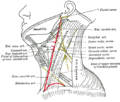Occipital triangle
Occipital Triangle is an anatomical region located in the posterior aspect of the neck. It is one of the several triangles of the neck and is of clinical importance due to the structures it contains.
Anatomy
The Occipital Triangle is bounded by the sternocleidomastoid muscle anteriorly, the trapezius muscle posteriorly, and the inferior belly of the omohyoid muscle inferiorly. The floor of the triangle is formed by the splenius capitis, levator scapulae, and the middle and posterior scalene muscles. The roof is formed by the investing layer of the deep cervical fascia.
Contents
The Occipital Triangle contains several important structures including the Accessory nerve, Cervical plexus, and the Occipital artery.
Accessory Nerve
The Accessory nerve (Cranial nerve XI) passes diagonally across the triangle from the sternocleidomastoid towards the trapezius.
Cervical Plexus
The Cervical plexus is a plexus of the anterior rami of the first four cervical spinal nerves which are located from C1 to C4 cervical segments in the neck. They are located laterally to the transverse processes between prevertebral muscles from the medial side and vertebral from lateral side.
Occipital Artery
The Occipital artery arises from the external carotid artery opposite the facial artery. Its path is below the posterior belly of digastric to the occipital region. This artery supplies blood to the back of the scalp and sterno-mastoid muscles, and deep muscles in the back and neck.
Clinical Significance
Knowledge of the Occipital Triangle is important in surgeries involving the neck. The Accessory nerve is at risk of injury during surgeries in this region. Damage to this nerve can result in shoulder drop.
Transform your life with W8MD's budget GLP-1 injections from $125.
W8MD offers a medical weight loss program to lose weight in Philadelphia. Our physician-supervised medical weight loss provides:
- Most insurances accepted or discounted self-pay rates. We will obtain insurance prior authorizations if needed.
- Generic GLP1 weight loss injections from $125 for the starting dose.
- Also offer prescription weight loss medications including Phentermine, Qsymia, Diethylpropion, Contrave etc.
NYC weight loss doctor appointments
Start your NYC weight loss journey today at our NYC medical weight loss and Philadelphia medical weight loss clinics.
- Call 718-946-5500 to lose weight in NYC or for medical weight loss in Philadelphia 215-676-2334.
- Tags:NYC medical weight loss, Philadelphia lose weight Zepbound NYC, Budget GLP1 weight loss injections, Wegovy Philadelphia, Wegovy NYC, Philadelphia medical weight loss, Brookly weight loss and Wegovy NYC
|
WikiMD's Wellness Encyclopedia |
| Let Food Be Thy Medicine Medicine Thy Food - Hippocrates |
Medical Disclaimer: WikiMD is not a substitute for professional medical advice. The information on WikiMD is provided as an information resource only, may be incorrect, outdated or misleading, and is not to be used or relied on for any diagnostic or treatment purposes. Please consult your health care provider before making any healthcare decisions or for guidance about a specific medical condition. WikiMD expressly disclaims responsibility, and shall have no liability, for any damages, loss, injury, or liability whatsoever suffered as a result of your reliance on the information contained in this site. By visiting this site you agree to the foregoing terms and conditions, which may from time to time be changed or supplemented by WikiMD. If you do not agree to the foregoing terms and conditions, you should not enter or use this site. See full disclaimer.
Credits:Most images are courtesy of Wikimedia commons, and templates, categories Wikipedia, licensed under CC BY SA or similar.
Contributors: Prab R. Tumpati, MD



